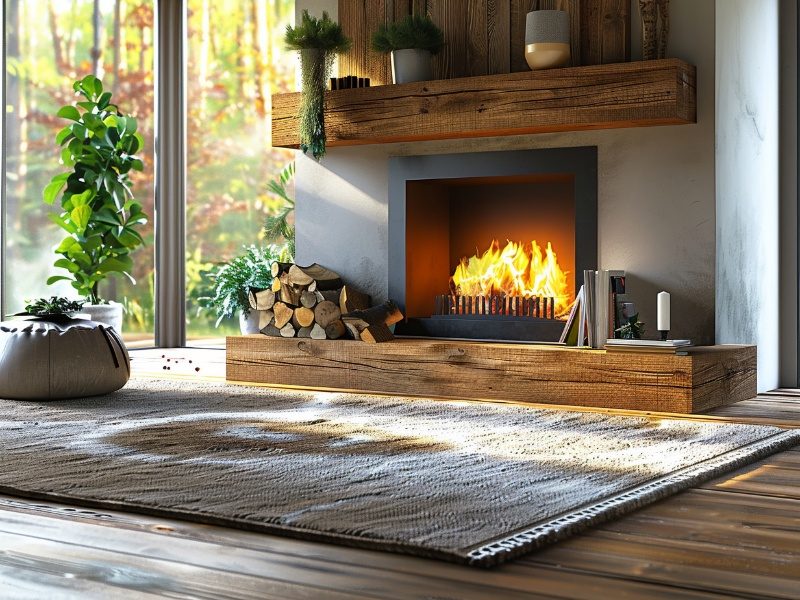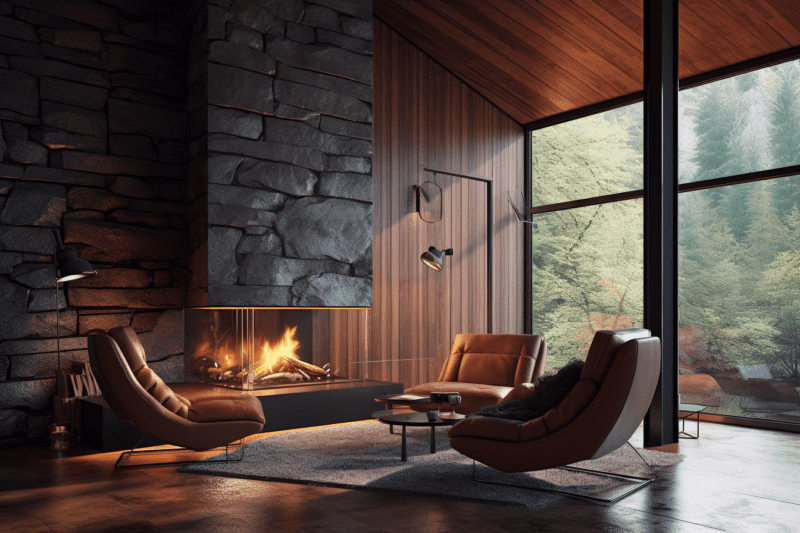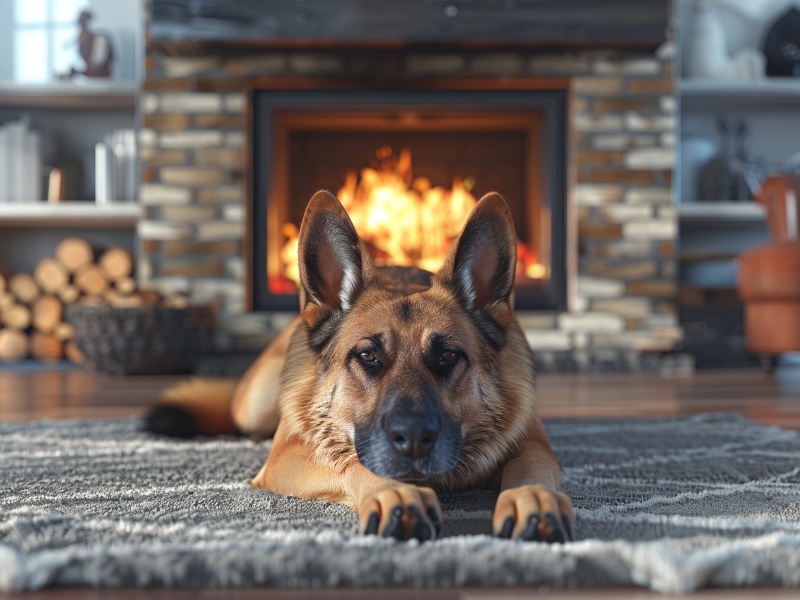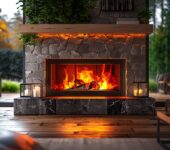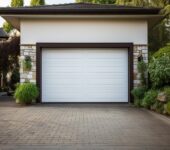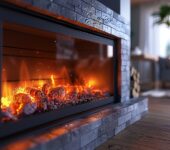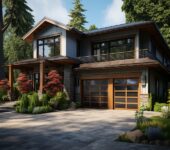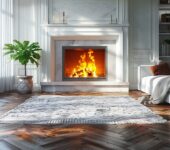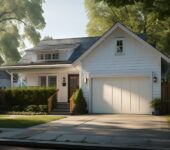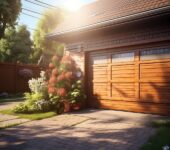Table of Contents
According to the National Association of Home Builders, about 55% of homebuyers said fireplaces were “desirable” or “essential”.
If you’re considering adding a gas fireplace to your home, you need to know the difference between vented gas logs and ventless fireplaces.
They both offer different benefits, and there are also some downsides.
In this guide, we are going to compare vented vs. ventless gas logs so you can make an informed decision.
Keep reading to learn about the cost of gas logs and how they work.
Quick Reference Guide: Vented vs. Ventless Gas Logs
| Feature | Vented Gas Logs | Ventless (Vent-Free) Gas Logs |
|---|---|---|
| Appearance and Ambiance | More realistic flame pattern, resembling a traditional wood fire. | Less realistic flame, doesn’t quite capture the essence of a wood fire. |
| Installation Requirements | Requires a functioning chimney or vent for the fumes to exit. Installation should be done by a professional. | Can be installed without a chimney or external venting, making installation easier and less restrictive. |
| Energy Efficiency | Less efficient as some of the heat escapes through the chimney. | More efficient since they release heat directly into the room without any loss through a chimney. |
| Cost of Installation and Operation | More expensive to purchase and install, especially if a chimney or vent isn’t already present. Operating cost around $0.52 per hour. | Cheaper to purchase and install due to no need for external venting. Operating cost about $0.25 per hour. |
| Safety and Air Quality | Considered safer as fumes are vented outside, maintaining better indoor air quality. | Raises concerns about indoor air quality due to emission of combustion products into the room, though they are designed to burn cleanly. May require additional ventilation measures. |
| Maintenance and Lifespan | Logs last about 10 years. Requires less frequent replacement but still needs regular inspection. | Logs need replacement every 3-5 years, suggesting more frequent maintenance. However, both types generally have a fireplace lifespan of 15-25 years. |
| Heat Output | Provides ambiance but loses some heat through the vent, making it less effective as a heat source. | Higher heat output as all the heat is directed into the room, making it more effective for heating. |
| Regulations and Restrictions | Fewer restrictions on installation, though it is dependent on having access to a chimney or vent. | Subject to more stringent regulations and may not be allowed in some states or municipalities due to concerns over indoor air quality. |
Vented Gas Log Fireplace
If you love the look and aesthetic of a real fireplace but are tired of cleaning up and burning real wood, then a vented fireplace may be a great option for you.
You can have these logs installed in your existing wood-burning fireplace.
These gas fireplaces can be fueled by propane or natural gas.
They release carbon monoxide, so you need a chimney or vent that allows the fumes to exit your home or commercial building.
Installing vented gas logs requires a professional and isn’t a project you should attempt on your own.
The contractor needs to be the one to hook up the gas lines to ensure your safety.
Vent Free Gas Log Fireplace
Vent-free, also known as Ventless or Non-Vented logs sets, are more efficient and don’t require a chimney.
This means lots of fumes and gases are being emitted into your house.
They are federally tested and contain safe levels of carbon monoxide because they burn cleaner.
However, because chemicals are released, you may want to invest in carbon monoxide and oxygen detectors.
However, it’s always important to follow the directions and not run your fireplace for too long.
You may even want to crack a window to add some fresh air back into your home.
They don’t look or smell like a real wood-burning fireplace.
Some states have restricted vent free gas logs.
You’ll need to check with your state, city, and county to ensure you can have a ventless fireplace installed.
If you ignore local laws, you could be asked to remove it and fined for not being in compliance with the building codes.
Cost To Install
Vented Fireplaces are more expensive to purchase and have installed, especially if you don’t have a vent or chimney.
You’ll likely pay between $3,500 and $8,000 depending on the quality of logs you purchase and the labor.
It will cost you about $0.52 per hour to run it.
For ventless fireplaces, you’ll pay somewhere between $1,000 and $5,000.
It’s much easier to install these logs because you won’t have to cut a hole in the wall or roof for ventilation.
It’s also slightly cheaper to run and will be about $0.25 an hour.
There are also fewer restrictions when it comes to installing ventless logs.
They can be placed anywhere in your home and don’t have to be near an exterior wall.
However, with that being said, it’s not recommended that you have them in bedrooms or run them for long periods of time.
Life Span
Both fireplaces have a lifespan of about 15 to 25 years. However, the logs themselves won’t last that long.
Logs are typically made of ceramic, which allows them to last longer than when they were made of cement.
Vented ones last a little longer, and you won’t need to replace them for about ten years, while you’ll need to switch out the ventless about every three to five years.
Having your logs and fireplace inspected once or twice a year can help extend the lifespan and ensure you’re safe.
If you depend on your fireplace as a main source of heat, you’ll want to schedule a maintenance check in the fall before winter comes.
Converting from Ventless to Vented
If you’ve previously bought and installed a ventless fireplace, or if the house you bought came with one, you might be thinking about switching to vented logs.
It sounds like it should be simple, but it’s not.
Unfortunately, you can’t just add vented logs to a ventless fireplace.
You’ll likely have to hire a contractor to take out the ventless one and install the vented one.
You’ll need to get a quote or estimate for the project, as it could cost you between $5,000 and $20,000.
Pros and Cons
There are pros and cons to both vented gas fireplace logs and ventless ones.
One of the great things about both vented and ventless systems is that there is minimal cleanup.
Vented are typically safer. However, they are not as efficient and will cost you a little more.
This is because the fumes are released through the chimney.
This also means that they don’t out as much heat.
Ventless logs are going to be less expensive but not as safe.
They may also make your home feel humid.
At the end of the day, you’ll have to decide which components are most important to you.
Gas fireplaces, both ventless and vented, can gas house fires, so you must keep anything flammable away from the fireplace.
This includes papers, blankets, and curtains.
Vented Gas Logs
When it comes to renovating your home and adding a fireplace, there are a lot of options, and it can be overwhelming.
However, knowing the difference between vented gas logs and ventless logs will help make your decision easier.
If you’re building your home or thinking about adding a fireplace to your existing house, contact us.
We have helped many homeowners, and we are confident that we can assist you with your decision.
FAQs
Q: What are the main differences between vented and non-vented gas logs?
A: Vented gas logs are more realistic in their flame pattern and appearance but require a fully functioning chimney for proper venting. Non-vented gas logs, on the other hand, are less realistic but can be installed in a fireplace without a functioning chimney because they are designed to burn gas more completely and release fewer emissions.
Q: Can you convert a vented gas log set to a non-vented one, and vice versa?
A: Generally, conversion between vented and non-vented gas logs is not recommended. Each type is specifically designed for their venting setup and improper conversion can lead to safety issues.
Q: Which type of gas logs, vented or non-vented, is more energy-efficient?
A: Non-vented gas logs are generally more energy-efficient because they retain and radiate more heat into your room, rather than losing it up the chimney like vented logs.
Q: How does the installation process differ for vented and non-vented gas logs?
A: Vented gas logs need to be installed in a fully operational wood-burning fireplace with a working chimney for proper venting, whereas non-vented gas logs can be installed in a regular fireplace, a specially made gas fireplace, or even in some cases, a gas insert.
Q: Are there any differences in maintenance and care for vented versus non-vented gas logs?
A: Both types require regular maintenance to ensure they’re working safely and efficiently. However, non-vented gas logs may require slightly more frequent servicing as they can produce more residue over time.
Q: Do vented and non-vented gas logs create different types of flame effects?
A: Yes, vented gas logs tend to create a more realistic flame that resembles a traditional wood fire, while non-vented gas logs produce a less natural but more consistent flame.
Q: Which type of gas logs are considered safer – vented or non-vented?
A: Both types can be safe if installed and used correctly. However, non-vented gas logs should have oxygen depletion sensors and be used in rooms with proper ventilation to avoid the buildup of carbon monoxide.
Q: Are there specific circumstances or situations where one type of gas log is better suited than the other?
A: Yes, for example, if you have a non-functioning chimney or prefer a more energy-efficient option, non-vented logs might be the best choice. Conversely, if you prefer a more realistic flame and your chimney is in good condition, vented logs could be more suitable.
Q: What are the implications on indoor air quality when using vented versus non-vented gas logs?
A: Vented gas logs direct most emissions outside via the chimney, resulting in better indoor air quality. Non-vented gas logs emit a small amount of their combustion products into your room, which can slightly affect indoor air quality.
Q: Which type of gas logs, vented or non-vented, provides more heat output?
A: Non-vented gas logs usually provide more heat output as they direct almost all the heat produced into the room, instead of up a chimney.
Latest Articles

What Is Cleanburn?
Table of Contents1 What Is Cleanburn?2 How Does Cleanburn Work?3 What Are the Benefits of Cleanburn?4 What Types of Appliances Use Cleanburn Technology?5 How to
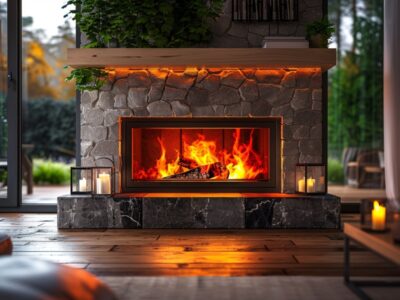
How Long Does It Take To Install A Fireplace?
Table of Contents1 Factors That Affect Installation Time2 How Long Does It Typically Take to Install a Fireplace?3 Factors That Can Extend Installation Time4 What

How To Frame Garage Doors On Rough Opening
Table of Contents1 What is a Rough Opening?2 How to Measure for a Garage Door Rough Opening?3 What Materials are Needed for Framing a Garage



